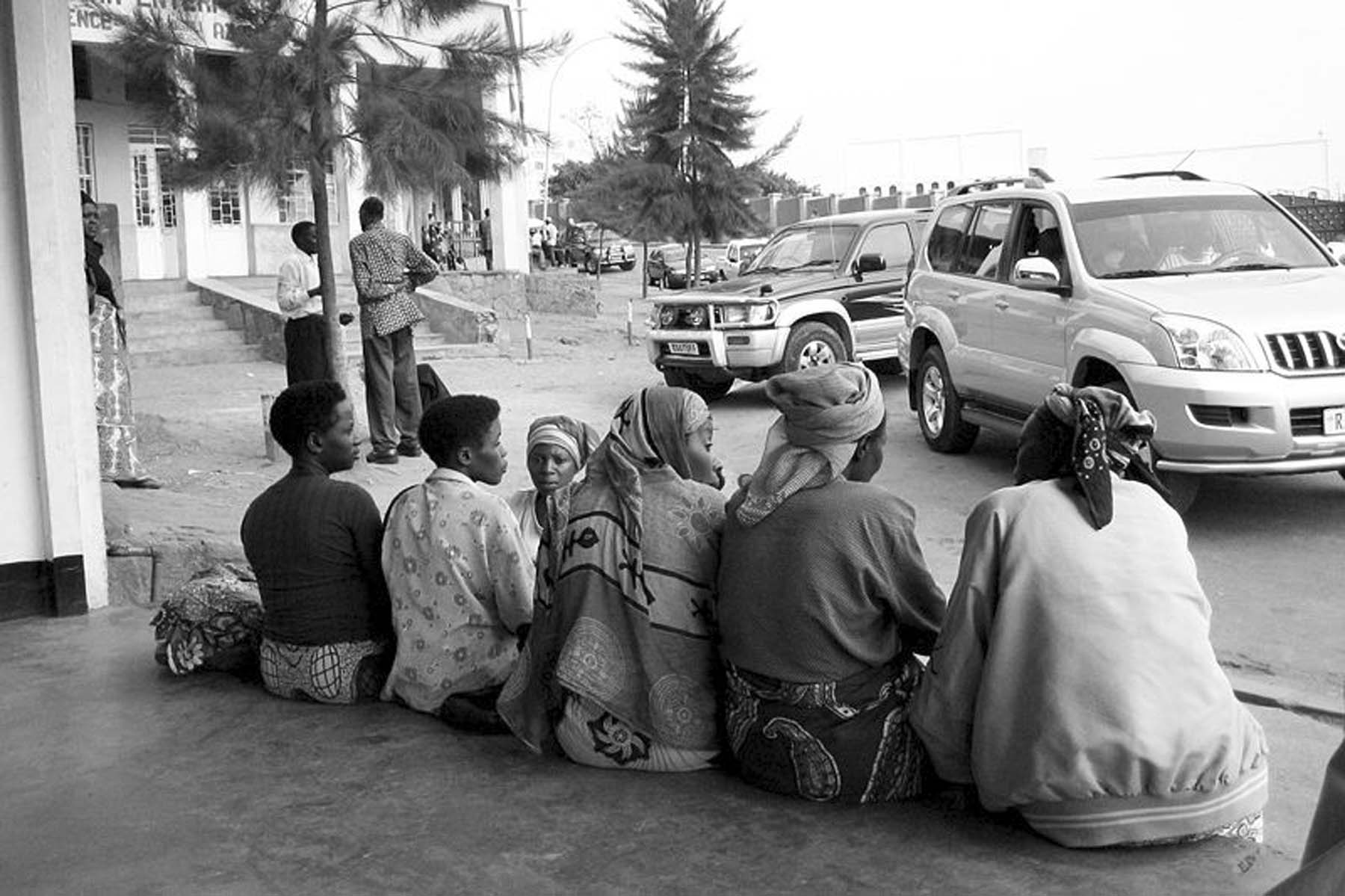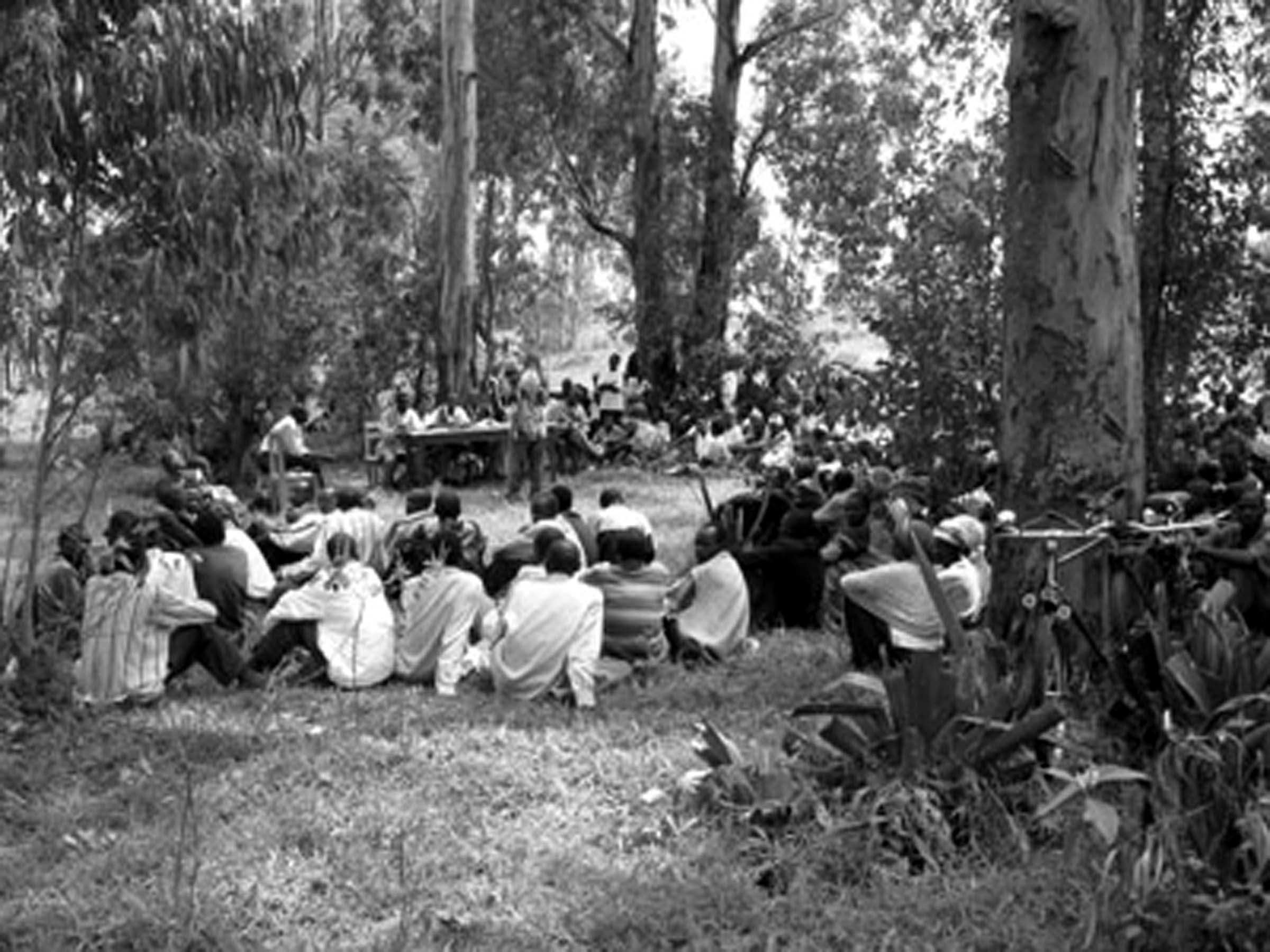
Women in Post-Genocide Rwanda:Facing the Past to Build a Future
It is broadly known that women have assumed outstanding leadership responsibility in Rwanda in the years since the 1994 genocide. During that three month period in 1994, roughly 800,000 people were murdered usually by their neighbours and with crude weapons such as machetes. The majority of those killed were Tutsis, the ethnic group targeted for genocide. But a significant number of Hutu people were also killed for refusing in one way or another to participate in the rampage.

Photo by Fanny Schertzer from Wikimedia Commons
The violence was ended by the victory of a Tutsi-led army which entered Rwanda from neighbouring Uganda. At the end of the genocide, nearly one million Hutu fled the country, fearing reprisals while several hundred thousand Tutsi returned to Rwanda from exile.
The drastic change in Rwanda’s demographics can be gleaned with the surviving women and girls who eventually constituted 70 per cent of the population.
Women and girls were certainly targeted for rape during the genocide. Aside from contaminating the ethnic genealogy of Tutsi women and girls, systemic rape was also meant to kill them in the end.
The Rwandan Genocide and its Sexual Violence
The Rwandan genocide was sparked by the assassination of Rwandan dictator Juvenal Habyarimana on 6 April 1994 as his plane was shot down. A few years before, a civil war ensued between the Rwandan Patriotic Front (RPF) that was led by the country’s president Paul Kagame and that mostly consisted of Tutsi refugees and the Habyarimana’s forces. This reignited the centuries of conflicts between the Hutus and the Tutsis. Although the Hutus have been the majority, taking over the political reins from the Belgians, the Tutsis had been regarded as a superior race, that they had politically and economically benefited during the colonial regime.
Following the assassination, the presidential guards, the military, politicians and some businesspeople organised that attacks against the Tutsis, leading to the formation of the militia called Interahamwe, among others. In a span of 100 days, the Hutus, encouraged by the mass media attacked their Tutsi neighbours as well as fellow Hutus who refused to participate in the carnage. By 1994, some 800,000 Rwandans were killed. Seven out of 10 Tutsis were wiped out.
While men were targeted for murder, women and girls were raped. In the trial of Taba mayor Jean Paul Akayesu, the International Criminal Tribunal for Rwanda recognised the systematic use of rape as a weapon of war. Hutus who were living with HIV-AIDS were encouraged to attack women and girls with the goal of eventually exterminating the Tutsi population. In 1996, the United Nations Special Rapporteur on Rwanda estimated that at least 250,000 women and girls were raped.
But the rapes did not stop in July 1994 nor was limited to Tutsis or Hutu women who married Tutsi men or sheltered their Tutsi neighbours. In their advance towards Rwanda and even after the genocide, RPF forces were also responsible for raping women and forcing them into marriages.
Aggravating the situation is the limited political and economic power of women under Rwanda’s customary laws. Thus, many survivors have been stigmatised, making it even more difficult for them to provide for their families. In many cases, they have been forced into sex work.
As the Human Rights Watch’s report Struggling to Survive reads: “Despite the adoption of inheritance law reform in 1999, women and girls are denied equal rights to land. In a society in which subsistence agriculture predominates, access to land often determines survival. Both women and girls are targets of sexual and other forms of gender-based violence, including domestic violence, rape, forced marriage, and polygamy. According to United Nations Children’s Fund (UNICEF), orphans and ‘other vulnerable children’ number approximately one million in Rwanda, and many of these children are particularly at risk of sexual assault and sexual exploitation, and resort to survival sex.”
Sources: Bristish Broadcasting Corporation (18 December 2009). “Rwanda: How the genocide happened.” and Human Rights Watch (29 September 2004). Struggling to Survive.
In fact, the Hutu leadership encouraged their men who were infected with HIV-AIDS to lead the raping of Tutsi women who eventually became pregnant and passed on the virus to their children.

Photo from Wikimedia Commons.
Today there is a large number of women who have survived rape and are living with HIV-AIDS, as well as raising children to whom they passed the virus. In many ways, the Rwandan genocide is an extraordinary lesson on the gender and generational dimension of acute violence. In the country, women bore the brunt of the genocide but even as some of them survived, they were forced to live with the trauma and pass it on to the next generation.
But such gender dimension is not only crucial in exacting accountabilities but in one’s personal healing and community’s reconstruction.
Today women represent 56 per cent of the lower house of the parliament and occupy eight out of the ten cabinet seats. Young girls are reaching unprecedented levels of scholastic achievement. One third of households is headed by women. Several civil society organisations have also sprouted, addressing the more specific needs of women. The efforts and achievements of women can make Rwandans can feel immense pride as they struggle to build a new country following such profound destruction.
However more than one decade since the genocide, more and more challenges await women. But the women have turned to their communities, contexts and creativity in confronting the past and move on to the future.
Physical violence against the female family members is so common that it is considered normal but Rwandan women have their own ways of subverting these norms, resisting violence, exacting accountability and renewing their spirit.
I have travelled to Rwanda many times over the past nine years, working with different organisations and projects on social healing and peacebuilding. With colleagues from the Karuna Centre for Peacebuilding, I have worked with women’s organisations to develop a cadre of experts in conflict resolution and transformation. I have also worked with local and international organisations that initiate regional campaigns on gender based violence (GBV).
The relationships that I have built with communities around the country have taught me more than I have learned in many years spent elsewhere. I remain amazed by the capacity of the human spirit to confront and transcend tragedy and betrayal. Having experienced such human extremity, Rwandans, especially their women have so much to share.
As with their counterparts elsewhere, Rwandan women are subjected by gender norms to perform much of the work. Physical violence against female family members is so common that it has been considered normal. Even when these women assume new roles, they cannot shed their existing roles in the hearth. But Rwandan women have their own ways of subverting these norms, resisting violence, exacting accountability and renewing their spirit.

Gacaca  Rwandans have found an alternative way of exacting accountability for those who took part in the genocide. Meaning “on the grass,” Gacaca is a traditional court where communities gather, sitting on the grass under the shade of trees. Judges selected based on their integrity sit on a bench and don sashes.
Rwandans have found an alternative way of exacting accountability for those who took part in the genocide. Meaning “on the grass,” Gacaca is a traditional court where communities gather, sitting on the grass under the shade of trees. Judges selected based on their integrity sit on a bench and don sashes.
According to Domitilla Mukantaganzwa, executive secretary of the Gacaca courts, “We don’t need only justice. We need also reconciliation. We need also to educate our population to show them that they are really the same population they are really the same community.” Aside from facilitating the healing process of individuals and communities, Gacaca also helps ease the dockets of the courts. It hears the cases of those who implemented orders from the genocide’s masterminds.
In the photo is the trial of John Pierre Munyakayanza. In 1994, the 19 year old Munyakayanza was assigned to one of the checkpoints where a Tutsi referred to as Colonel was chased and killed. In a report by Jeb Sharp of Public Radio International, Munyakayanza admitted being there but denied that he killed Colonel or anyone. In the end, he was sentenced to six years of imprisonment and two years of community service. But since he had already spent six years in prison before he was tried by Gacaca, he would only have to perform community service. The verdict was eventually appealed as some say that the sentence was too light.
Although Gacaca is quite innovative, the system is fraught with challenges. Many people have yet to process their own experience of the genocide, and resort to killing witnesses and survivors. There are also problems in the confessions. Some are incomplete to avoid the implication of kins or retaliation — a point which Bonaventure Nyibisi find disturbing.
In his interview with Sharp, he said, “You have all these people who are recognising that they have killed. Not one person, not two not five not ten but so many people. And in this case they were all involved in the killing of my mother and all of them are free on the basis that they have confessed and what is even more disturbing because I don’t see the confession that they are doing being genuine it is because they have been able to read the law to follow the process and say if we do this then we will be free.”
There are currently 1,200 Gacaca courts nationwide.
Source: Sharp, Jeb (14 February 2007). “Rwanda’s Gacaca Courts.”
They are not keen on direct confrontation nor on solidarity. At times they mistrust other women who gain power. The country’s uneven development with the urban and rural divide further heightens the differences among women. Urban women are generally highly educated, have greater access to services and have “globalised” perspectives. Meanwhile, the very notion of gender is hardly appreciated with the male power structures in the villages. It is for this reason that the likelihood of GBV is higher in the country than in the city.
Of course there is also rich interplay, with educated women committing time and effort tobuilding alliances with women in rural areas – an interface that becomes advantageous to both.
But one of the venues of interface and solidarity among Rwandan women is Gacaca.
Gacaca is a traditional litigation process that has been used for crimes of genocide.
It is also innovative in the sense that it speeds up trials that would have progressed at a snail’s pace in the formal courts. Accomplished at the village level in the last several years, Gacaca is an ongoing experiment in transitional and restorative justice unlike any the world has ever witnessed before.
Everyone is expected to participate. In fact, there are sanctions if one withholds evidence. The judges are local citizens chosen by their peers on the basis of their integrity. Once the case is complete, the judges retire to decide on a sentence. Penalties can include a combination of prison and community service or can be completed entirely in the form of community service.
Gacaca is both a risk and an opportunity for Rwandan women. Standing up in public to testify on experiences that are personal and sensitive runs counter to Rwandan culture. To begin with, to share the story of a sexual crime even in the presence of family members is a disturbing process in itself. Accusing others, usually men, who have committed grave violence is dangerous. But not telling the truth is also risky as someone else may know one is lying. Perjury is a criminal offense.
Yet women have played an enormous and pivotal role in the Gacaca as judges, victims, accused and testifiers. As one participant, who initially had qualms over Gacaca shared, “The cycle of revenge and reconciliation helped me to see that in keeping silent I was contributing to the repetition of the cycle, that my silence was a victory for those who had harmed others. Likewise to participate is to be an active contributor to the healing of our country, to the construction of the history of what happened to our country, and to my own healing.”
International Criminal Tribunal for Rwanda
In 1994, the United Nations Security Council set up the International Criminal Tribunal for Rwanda (ICTR) to prosecute individuals responsible for the genocide. A year later, the court was relocated to neighbouring Tanzania. While the transfer may have eased tensions in Kigali and elsewehere in the country, some are also saying that this has disabled ordinary Rwandans from participating in the process. Moreover, women’s organisations have also complained that the court failed to reveal and analyse details of rape incidents.
ICTR was supposed to complete its work by 2004. However, given the number of cases being heard, the deadline has been moved to 2012. Out of the 38 verdicts it made, only six were acquittals.
Among those who were convicted were media practioners who encouraged Hutus to spur violence against the Tutsis. These were Hassan Ngeze of newspaper Kangura, Ferdinand Nahimana and Jean-Bosco Barayagwiza of the popular radio station RTLM. Some supporters of Kangura advised the use of machetes in killing the Tutsis. Similarly RTLM broadcast information on the hiding places of the Tutsis. One of these places was a mosque that was immediately bombed by the Hutus.
Ngeza and Nahimana received a sentence of life imprisonment while Barayagwiza was handed 27 years of imprisonment.
Sources: British Broadcasting Corporation (18 December 2009). “Rwanda war crimes court extended.”; Human Rights Watch (29 September 2004). Struggling to Survive. and LaFraniere, Sharon (4 December 2003). “Court convicts 3 in 1994 genocide across Rwanda.”
Gacaca allows women to articulate themselves and on their families’ behalf for the process of seeking justice. By speaking up and placing the guilt publicly where it belongs, not only helps obtain justice but constitutes a healing potential for individuals.
This leads me to one last reflection. People in other countries tend to think of horror when they hear the word Rwanda. The country has been flooded for many years with people coming from all over the world to “help”. I put the word in quotes because all of us outsiders arrive initially without the eyes to see how Rwandans are living, coping, enduring and transforming their lives. We bring what we imagine people need.
Gacaca is both a risk and an opportunity for Rwandan women. Standing up in public to testify on experiences that are personal and sensitive runs counter to Rwandan culture. Speaking up and placing the guilt publicly where it belongs, not only helps obtain justice but constitutes a healing potential for individuals.
Rwanda is full of people who have lost their own children and who are carefully raising the orphaned children of others. There are countless ways in which Rwandans have seared the wounds they sustained, regardless of their ethnicity. They have converted their pain and bitterness into a determination to survive and build a better future for new generations.
This is not to underestimate the degree of trauma and anguish which remains part of the daily lives of many Rwandans, who look for support in their families and their communities. But to witness the degree to which Rwandans smile, extend their hands and commit themselves to care for others despite their marred personal and political history make me, an outsider rethink. They have faith that far surpasses our own expectations of our less tested lives with less contribution.





 The
The 
 Isis Resource Center holds one of the largest feminist collections of materials in the Global South. With 40 years of publication experience, Isis holds a vast collection.
Isis Resource Center holds one of the largest feminist collections of materials in the Global South. With 40 years of publication experience, Isis holds a vast collection.